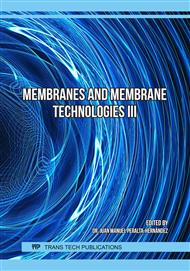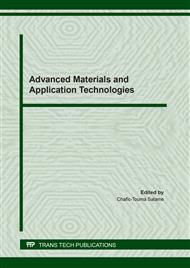[1]
Marshall, Alan G., and Ryan P. Rodgers. Petroleomics: Chemistry of the underworld., Proceedings of the National Academy of Sciences 105.47 (2008): 18090-18095.
DOI: 10.1073/pnas.0805069105
Google Scholar
[2]
Javadli, Rashad, and Arno De Klerk. Desulfurization of heavy oil., Applied Petrochemical Research 1.1-4 (2012): 3-19.
DOI: 10.1007/s13203-012-0006-6
Google Scholar
[3]
Jabur, Akram R., Laith K. Abbas, and Safa M. Muhi Aldain. Ambient Temperature Affect the Pore size of PVA Nanofibers Tissues., Engineering and Technology Journal 33.6 Part (B) Scientific (2015): 1040-1047.
DOI: 10.30684/etj.35.4a.5
Google Scholar
[4]
Chayad, Fadhil A., Akram R. Jabur, and Shaimaa J. Kareem. The microstructure and characterization of nickel ferrite nanofibers., Advances in Natural and Applied Sciences 10.8 (2016): 48-56.
Google Scholar
[5]
Jabur, Akram Raheem, Laith Kais Abbas, and Saja Aqeel Moosa. Antibacterial Activity of Electrospun Silver Nitrate/Nylon 6 Polymeric Nanofiber Water Filtration Mats., Al-Khwarizmi Engineering Journal 13.1 (2017): 84-93.
DOI: 10.22153/kej.2017.10.001
Google Scholar
[6]
Kumar, Palaniswamy Suresh, et al. Hierarchical electrospun nanofibers for energy harvesting, production and environmental remediation., Energy & environmental science 7.10 (2014): 3192-3222.
DOI: 10.1039/c4ee00612g
Google Scholar
[7]
Jabur, Akram R., Majid H. Abdulmajeed, and Shafaq Y. Abd. Effect of Cu nanoparticles addition on improving the electrical conductivity and mechanical properties of PVA electrospun polymeric film., AIP Conference Proceedings. Vol. 1968. No. 1. AIP Publishing LLC, 2018.
DOI: 10.1063/1.5039203
Google Scholar
[8]
R Jabur, Akram, Laith K Abbas, and Saja A Moosa. Fabrication and Characterization Membrane Prepared from Oxidized Multiwall Carbon Nanotube/Nylon 6 Composite., journal of kerbala university 11.3 (2015): 200-212.
Google Scholar
[9]
Kim, Eun-Sik, et al. Development of nanosilver and multi-walled carbon nanotubes thin-film nanocomposite membrane for enhanced water treatment., Journal of membrane science 394 (2012): 37-48.
DOI: 10.1016/j.memsci.2011.11.041
Google Scholar
[10]
Jabur, Akram R. Antibacterial activity and heavy metal removal efficiency of electrospun medium molecular weight chitosan/nylon-6 nanofibre membranes., Biomedical Materials 13.1 (2017): 015010.
DOI: 10.1088/1748-605x/aa9256
Google Scholar
[11]
Eda, Goki, and Satya Shivkumar. Bead structure variations during electrospinning of polystyrene., Journal of materials science 41.17 (2006): 5704-5708.
DOI: 10.1007/s10853-006-0069-9
Google Scholar
[12]
R.M. Nezarati, M.B. Eifert, E. Cosgriff-Hernandez, Effects of humidity and solution viscosity on electrospun fiber morphology, Tissue Eng. Part C Methods. 19 (2013): 810–819.
DOI: 10.1089/ten.tec.2012.0671
Google Scholar
[13]
Jabur, Akram R., Fadhil A. Chayad, and Noor M. Jalal. Fabrication and characterization of nylon 6/MWCNTs conductive polymer by electrospinning technique., International Journal of Thin Films Science and Technology 5.2 (2016): 1-9.
DOI: 10.18576/ijtfst/050205
Google Scholar
[14]
Chayad, Fadhil A., Akram R. Jabur, and Noor M. Jalal. Effect of MWCNT addition on improving the electrical conductivity and activation energy of electrospun nylon films., Karbala International Journal of Modern Science 1.4 (2015): 187-193.
DOI: 10.1016/j.kijoms.2015.10.004
Google Scholar
[15]
Jalal, Noor M., et al. Preparation, Microstructure and Morphology of Electrospun Sulfonated Polystyrene Films for Proton Exchange Membrane Hydrogen Fuel Cell., Energy Procedia 157 (2019): 1494-1505.
DOI: 10.1016/j.egypro.2018.11.314
Google Scholar
[16]
Fang, JunFei, YiMin Xuan, and Qiang Li. Preparation of polystyrene spheres in different particle sizes and assembly of the PS colloidal crystals., Science China Technological Sciences 53.11 (2010): 3088-3093.
DOI: 10.1007/s11431-010-4110-5
Google Scholar
[17]
Brugnara, M. A. R. C. O., et al. Wettability of porous materials, II: Can we obtain the contact angle from the Washburn equation., Contact angle, wettability and adhesion 4.143-164 (2006): 192.
DOI: 10.1201/b12166-11
Google Scholar
[18]
Wu, Jingya, et al. CNTs reinforced super-hydrophobic-oleophilic electrospun polystyrene oil sorbent for enhanced sorption capacity and reusability., Chemical Engineering Journal 314 (2017): 526-536.
DOI: 10.1016/j.cej.2016.12.010
Google Scholar
[19]
Svinterikos, Efstratios, Ioannis Zuburtikudis, and Mohamed Al-Marzouqi. Carbon nanomaterials for the adsorptive desulfurization of fuels., Journal of Nanotechnology (2019): 1-3.
DOI: 10.1155/2019/2809867
Google Scholar
[20]
Crespo, Dennis, and Ralph T. Yang. Adsorption of organic vapors on single-walled carbon nanotubes., Industrial & engineering chemistry research 45.16 (2006): 5524-5530.
DOI: 10.1021/ie051106b
Google Scholar
[21]
Khaled, Mazen. Adsorption performance of multiwall carbon nanotubes and graphene oxide for removal of thiophene and dibenzothiophene from model diesel fuel., Research on Chemical Intermediates 41.12 (2015): 9817-9833.
DOI: 10.1007/s11164-015-1986-5
Google Scholar



